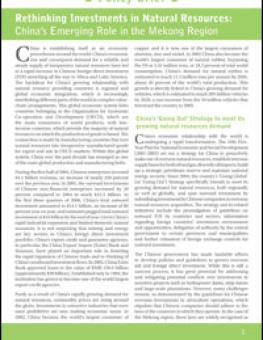
Rethinking Investments in Natural Resources: China's Emerging Role in the Mekong Region (Policy Brief)
China's economic rise and consequent demand for a reliable and steady supply of inexpensive natural resources have led to a rapid increase in Chinese foreign direct investment stretching all the way to Africa and Latin America. Southeast Asia's Mekong region is no exception to that trend. This policy brief highlights China's emerging role in finance and trade in three selected Mekong region countries (Cambodia, Laos and Vietnam). The focus is on investments in the agribusiness, hydropower and mining industries where Chinese companies and banks are steadily gaining influence in the region.
Key findings:
-
The Chinese government provides considerable foreign aid to Cambodia, Laos and Vietnam, often without any major conditions attached. With the exception of hydropower projects in Cambodia, China's aid is not usually linked to the agribusiness, hydropower and mining sectors, but rather focuses on infrastructure, education and construction.
-
China's trade structure with Cambodia, Laos and Vietnam is presently dominated by China's imports of natural resources and exports of manufactured goods. This stands in marked contrast to the structure of trade between China and some other Southeast Asian countries, such as Malaysia, the Philippines and Thailand, where the trade structure is more complex and exports to China are less resource-intensive.
-
The principal difference among the three countries in their relationship with China is in the relative importance of investment and trade. China is the leading investor in Cambodia and Laos, while for Vietnam, trade with China, its largest trading partner, is most significant. Vietnam is itself emerging as an investor in natural resources in Cambodia and Laos.
-
Chinese state-owned enterprises are becoming major investment players in the region, fuelling natural resources extraction in Cambodia, Laos and Vietnam. They dominate hydropower projects and provide an important source of investment capital for agricultural inputs in the two countries in Cambodia and Laos, and are beginning to invest in mineral exploitation in all three countries.
-
China is starting to make efforts to improve its profile in the international arena by showing its willingness to take on board international best practices, public participation strategies and green credit policies, among others. However, many of the mainly state-owned Chinese companies operating in the mining and hydropower sectors continue to have a poor social and environmental track record abroad.
Key recommendations:
-
China has the opportunity to become a global leader in environmentally and socially sustainable investment by carefully monitoring Chinese overseas investments, strengthening its own investment regulations and adopting international best practices and principles.
-
The onus cannot be on China alone. China will need to partner with governments within the countries it operates in order to help resource providers strengthen their own regulations, which does not necessarily have to come at the expense of investment inflows.
You might also be interested in
December 2024 | Carbon Minefields Oil and Gas Exploration Monitor
In November 2024, 23 oil and gas exploration licences were awarded across five countries, with Russia granting the licences that account for the largest portion of embodied emissions.
Toward a Coherent, Transformative Approach to Financing Sustainable Development, Climate, and Nature
Four key proposals for the Fourth Financing for Development Conference (FfD4) to create an integrated, equitable approach to financing climate, nature, and development goals.
Green Public Procurement in India
This report analyzes the status of green public procurement (GPP) in India and suggests key strategies for advancing sustainable procurement practices.
Sustainable Asset Valuation (SAVi) of a Small-Scale Tree Planting Initiative in Côte d'Ivoire
This report analyzes the social, economic, and environmental outcomes of a small-scale tree planting initiative at schools in Côte d'Ivoire.